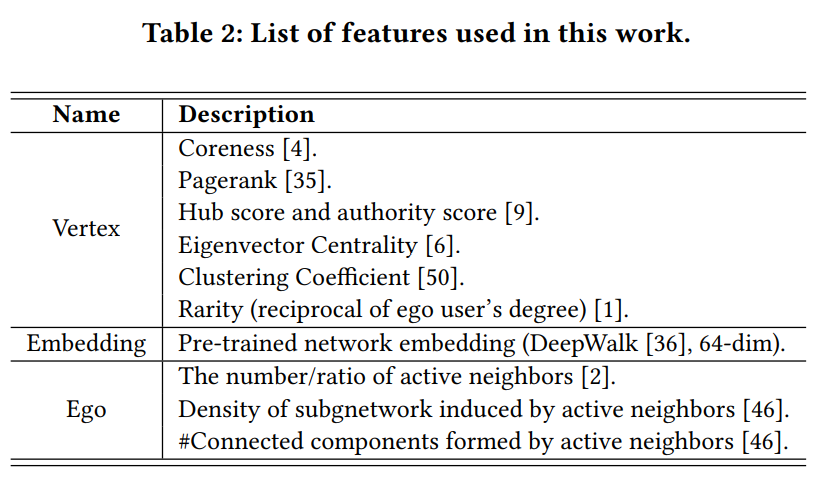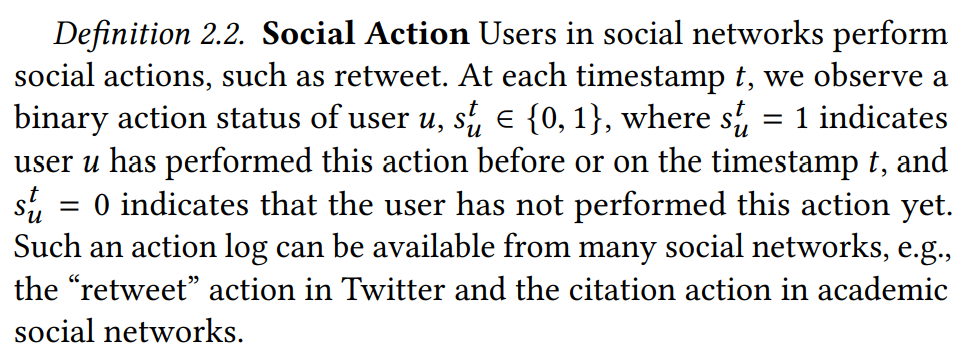1. 前言
在公众号看到一篇感兴趣的论文:

pdf地址:https://arxiv.org/pdf/1807.05560.pdf
代码地址:https://github.com/xptree/DeepInf
2. 阅读笔记
DeepInf: Social Influence Prediction with Deep Learning
2.1 研究点的引出
在摘要中作者也提出了本文的研究其实为“social influence prediction”,也即是社交影响预测。
- 传统的“社交影响预测”方法依赖于人工定义的规则来抽取用户和网络特征,然而这些方法受限于个人相关专业领域的知识。
- 因此,作者在本文中设计了一个深度神经网络“DeepInf”,来学习用户潜在的特征表示,进而预测社交影响。
- 具体而言,本文设计了一些策略去整合网络结构、用户特征。
读到这里,那么本文所认为的传统的“社交影响预测”方法有哪些?不妨先看看对比的方法:
Logistic Regression(LR),逻辑回归。Support Vector Machine(SVM),支持向量机。PSCN,作者原文是这样说的:“As we model social influence locality prediction as a graph classification problem, we compare our framework with the state-of-the-art graph classification models, PSCN[34].”,译:当我们将社会影响位置预测建模为图分类问题时,我们将我们的框架与最先进的图分类模型 PSCN [34] 进行比较。
那么这三个基线方法为什么能够成为作者本文所描述的“传统”社交网络预测方法?
作者将其分为两类,在 LR 和 SVM 中,均考虑使用三类特征(Vertex, Embedding, Ego),如下图:

对于Vertex和Embedding很好理解,也就是节点特征和DeepWalk64 维的嵌入表示,那么在Ego中的active neighbors是什么意思?继续查看一下给出的相关参考文献:
- Group formation in large social networks: membership, growth, and evolution.
在这篇论文中也提到了,“Of those communities which had at least 1 post, we selected the 700 most active communities along with 300 at random from the others with at least 1 post.”
也就是选择预定义数目的最活跃(有发帖)的群体以及随机选择。
也就是第三个特征Ego其实也就是作者自己定义的“最活跃”。
回到主题,也就是在LR和SVM中将上述三种特征(Vertex, Embedding, Ego)作为分类器的训练数据,进而进行分类训练。
注意到,PSCN 来自论文:“Learning convolutional neural networks for graphs, ICML’2016”,也是一个考虑使用图网络的分类研究。
2.2 相关工作
从前一小节我们知道,可以说本文(DeepInf: Social Influence Prediction with Deep Learning)的研究其实也就是一篇图分类的研究,使用的手段为图深度神经网络。那么和“Social Influence Prediction”之间有什么关联?下面带着这个疑问开始引言的阅读。
社交影响:“refers to the phenomenon that a person’s emotions, opinions, or behaviors are affected by others.”
“there is little doubt that social influence has become a prevalent, yet complex force that drives our social decisions, making a clear need for methodologies to characterize, understand, and quantify the underlying mechanisms and dynamics of social influence.”
简单来说,社交影响也就是对他人观点、情感、决策的影响,且在文献[26, 32, 42, 43]中进行了研究。
作者目标:“We aim to predict the action status of a user given the action statuses of her near neighbors and her local structural information.”
具体过程为:DeepInf, to represent both influence dynamics and network structures into a latent space. To predict the action status of a user v, we first sample her local neighbors through random walks with restart. After obtaining a local network as shown in Figure 1, we leverage both graph convolution and attention techniques to learn latent predictive signals.
使用随机游走来获取用户结构特征,关于社交影响,文中在第二节进行介绍。
2.3 社交影响
2.3.1 r-neighbors
也就是最短路径小于等于r的节点的集合:

而上述节点的集合构成的子图,称为r-ego netwrok,描述为:

2.3.2 Social Action
这里的描述很高级,记录一下:

2.3.3 Social Influence Locality
根据上述引入两个定义,这里引入了“Social Influence Locality”的概念。因为在“Social Action”中引入了时间序列的转发行为表示,故而在“Social Influence Locality”这个概念中同样引入了时间序列的概念:
在下一个时刻激活概率为:

假定有 N 个实例,那么总体的社交影响预测问题的目标为:

2.4 DeepInf
-
步骤一:邻居采样,使用
BFS抽取出节点v的r-ego网络,表示为 G v r G^{r}_v Gvr。但是这个网络的大小可能由于“小世界”特性而特别大,为了解决这个问题,进行了大小的控制,可以理解为在r-ego网络上进行二次采样;采样过程根据边的权重的比例进行采样(即有偏),此外在每个时间步骤都有一定概率会重头开始随机游走, -
步骤二:神经网络模型,主要目的是为了节点整合结构属性以及行为状态,最终用来预测用户的转发行为状态(即:0 或者 1)。

注意到(d)的特征由两部分组成,(是否激活,是否是 ego)以及其网络嵌入。
在上图中的中间部分都比较常见,这里不再介绍。着重看下最终的对比部分:

完全变成了一个分类问题,也就是是否转发。
最终的对比实验也是引用了逻辑回归、支持向量机等,将其分类,然后对比分类效果的好坏。
3. 总结
根据前面的阅读,我们知道其实作者论文“DeepInf: Social Influence Prediction with Deep Learning”
在解决的问题也就是嵌入可能影响因素,然后预测用户是否会转发消息。
个人感觉题目的“Social Influence Prediction”很高级。